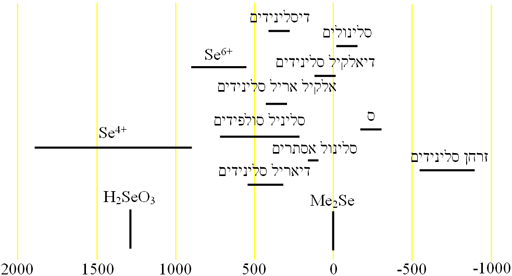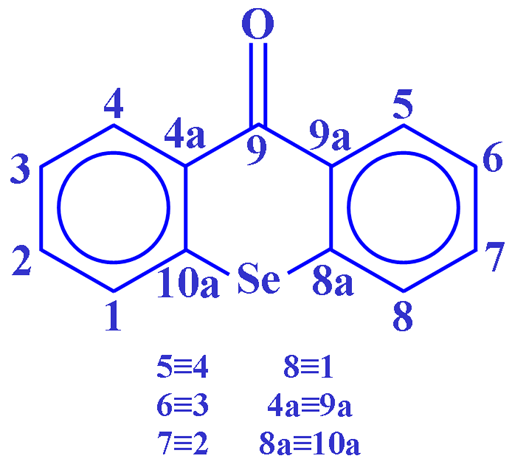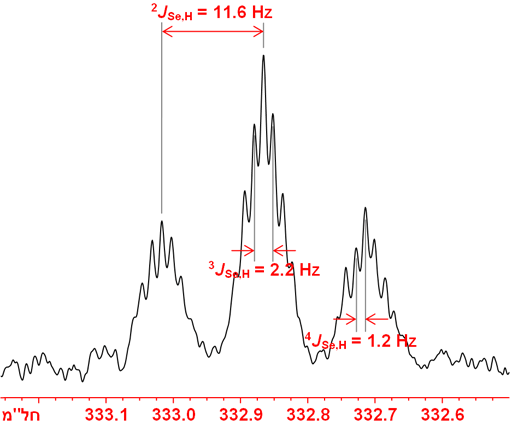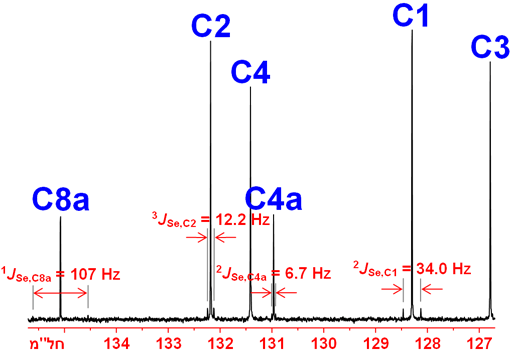תמג סלניום (77Se)
77סלניום (77Se) הוא גרעין ספין חצי בעל רגישות נמוכה שנותן סיגנלים חדים פרוס על טווח היסט כימי רחב מאוד. לכל סוג של תרכובת סלניום יש תחום היסט הכימי ייחודי (תרשים 1).
תרשים 1. טווחי היסט כימי של סלניום עם הפרת צימוד מפרוטון

משתמשים בתמ"ג (תרשים 2) הרבה לחקור תרכובות אורגנוסלניום כמו סלנוזנתנון (תרשים 3) ובחקר קשירת סלניום לחבונים.
תרשים 2. ספקטרום תמ"ג 77Se של סלנוזנתנון (0.1M) ב-CDCl3 עם הפרת צימוד מפרוטון

תרשים 3. מבנה מולקולרי של סלנוזנתנון

סלניום מרבה להראות צימוד לגרעינים אחרים, 1H, 13C, 15N, 19F, 31P, וכו'. בנוסף הוא מראה צימוד הומוגרעיני עם צימוד סלניום-סלניום תלת-קשרי בין 10 ל-100 הרץ תלוי בסטריוכימיה. ניתן הפר צימוד מפרוטון כמו בתרשים 2. הפקטרום הצמוד של סלנוזנתון (תרשים 4) מראה צימוד דרך שלושה קשרים ל-H1 (3JSe,H) של 11.6 הרץ, דרך ארבע קשים ל-H2 (4JSe,H) ודרך חמישה קשרים ל-H3 (5JSe,H) של 1.2 הרץ. לא הובחן צימוד דרך ששה קשרים אך הוא צפוי להיות בסביבות 0.5 הרץ.
תרשים 4. ספקטרום תמ"ג 77Se של סלנוזנתנון (0.1M) ב-CDCl3 שמראה צימוד לפרוטון

צימוד לסלניום נראה כלווינים על ספקטרום הפרוטון (תרשים 5). הם מופיעים רק כלווינים משום ששכיחות 77Se היא רק 7.63%.
תרשים 5. ספקטרום תמ"ג 1H של סלנוזנתנון (0.1M) ב-CDCl3 שמראה צימוד לסלניום

צימוד ל-13C מופיע כסיגנלי לווין קטנים בספקטרום ה-77Se (תרשים 6). כאן מופיע צימוד עד לשלושה קשרים. קבועי צימוד חד קשריים בסביבות 100 הרץ, צימוד דרך שניים או שלושה קשרים נעים בין 5 עד 35 הרץ וצימוד לטווח ארוך יותר פחות מ-3 הרץ.
תרשים 6. ספקטרום תמ"ג 77Se של סלנוזנתנון (0.1M) ב-CDCl3 עם הפרת צימוד מפרוטון שמראה לווינים שנוביעם מצימוד ל-13C

צימוד בין סלניום לפחמן מופיע כלווינים בסיגנלים של ספקטרום תמ"ג 13C (תרשים 7).
תרשים 7. ספקטרום תמ"ג 13C של סלנוזנתנון (0.1M) ב-CDCl3 עם הפרת צימוד מפרוטון שמראה לווינים שנוביעם מצימוד ל-77Se

תכונות גרעין ה-77Se
| תכונה | ערך |
|---|---|
| ספין | 1/2 |
| שכיחות בטבע | 7.63% |
| תחום ההיסט הכימי | 3000 ppm, בין -2000 ל-1000 |
| יחס התדירויות (Ξ) | 19.071513% |
| חומר יחוס (נקודת אפס יחסית) | Me2Se |
| רוחב פס של חומר הייחוס | ~0.5 הרץ |
| זמן התפוגה T1 של חומר הייחוס | שניות ~30 |
| רגישות יחסית ל-1H בשכיחות טבעית | 5.37 × 10-4 |
| רגישות יחסית ל-1H כאשר מועשר | 7.04 × 10-3 |
| רגישות יחסית ל-13C בשכיחות טבעית | 3.15 |
| רגישות יחסית ל-13C כאשר מועשר | 41.3 |
מקורות
- M. Lardon, "Selenium and proton nuclear magnetic resonance measurements on organic selenium compounds", J. Am. Chem. Soc., 92, 5063-5066 (1970).
- W. McFarlane and D. S. Rycroft, "Signs of nuclear spin-spin coupling constants involving selenium. Effect of electron lone pairs", J. Chem. Soc. Chem. Commun., 10-11 (1973).
- S. Gronowitz, I. Johnson and A. B. Hornfeldt, "Selenium-77 NMR studies of organoselenium compounds. I. Selenium-77 NMR parameters of monosubstituted selenophenes", Chem. Script., 8, 8-14 (1975).
- L. Christiaens, J. L. Piette, L. Laitem, M. Baiwir, J. Denoel and G. Llabres, "Selenium-77 NMR of organoselenium compounds", Org. Magn. Reson., 8, 354-356 (1976).
- A. Fredga, S. Gronowitz and A. B. Hornfeldt, "Selenium-77 NMR studies of organoselenium compounds. IV. Benzyl- and arylseneinic acids", Chem. Script., 11, 37-38 (1977).
- G. A. Kalabin, D. F. Kushnarev and V. M. Tschmutova, "Proton, carbon-13, and selenium-77 NMR spectra of substituted selenoanisoles", Org. Magn. Reson., 12, 598-604 (1979).
- R. Keat, D. S. Rycroft and D. G. Thompson, "Selenium-77 chemical shifts of cylodiphosphazene selenides", Org. Magn. Reson., 12, 391-392 (1979).
- B. Kohne, W. Lohner, K. Praefcke, H. J. Jakobsen and B. Villadsen, "Spectroscopic investigations XVII. 77Se and 125Te NMR resonances of some selenol and tellurol esters", J. Organometal. Chem., 166, 373-377 (1979).
- G. Llabres, M. Baiwir, J. L. Piette and L. Christiaens, "Selenium-77, carbon-13 and proton NMR investiagation on ortho-carbonyl benzeneselenyl derivatives", Org. Magn. Reson., 15, 152-154 (1981).
- N. V. Onyamboko, M. Renson, S. Chapelle and P. Granger, "Carbon-13 and Selenium-77 spectra of thienoisoselenazoles, selenoloisothiazoles, selnoloisoselnazoles, and thienoisothiazoles", Org. Magn. Reson., 19, 74-77 (1982).
- D. F. Kushnarev, G. A. Kalabin, R. A. Kyandzhetsian and N. N. Magdesieva, "NMR spectroscopy of organic compounds of selenium and tellurium. X. Chemical shifts of selenium-77 in selenonium ylides", Zh, Org. Khim., 18, 119-124 (1982).
- M. Baiwir, G. Llabres, L. Christiaens and J. L. Piette, "NMR studies of the chalcogen analogs of benzofuran. IV. Proton, carbon-13 and selenium-77 magnetic resonance in nitrobenzo[b]selenophenes", Org. Magn. Reson., 18, 33-37 (1982).
- N. P. Luthram R. B. Dunlap and J. D. Odom "Selenium-77 NMR studies of organic selenyl sulfides", J. Magn. Reson., 46, 152-157 (1982).
- I. Johannsen and H. Eggert, "Selenium-77 NMR. Observation of 3JSe-Se coupling allowing cis/trans isomer assignments in substituted tertaselenfulvalenses", J. Am. Chem. Soc., 106, 1240-1243 (1984).
- H. Duddeck, P. Wagner and S. Gegner, "Dynamic 77Se NMR of phenylselenyl cyclohexane derivatives", Tetrahed. Lett., 26, 1205-1208 (1985).
- H. Eggert, O. Nielson and L. Henriksen, "Selenium-77 NMR. Application of JSe-Se to the analysis of dialkyl selenides", J. Am. Chem. Soc., 108, 1725-1730 (1986).
- I. Johannsen, L. Henrikson and H. Eggert, "Selenium-77 NMR. 2. The basis for application of JSe-Se and JSe-H in structure assignments of mono-, di-, and triseleno-substituted alkenes", J. Org. Chem., 51, 1657-1663 (1986).
- K. S. Tan, A. P. Arnold and D. L. Rabenstein, "Selenium-77 nuclear magnetic resonance studies of selenols, diselenides, and selenyl sulfides", Can. J. Chem., 66, 54-60 (1988).
- B. Wrackmeyer, B. Distler, S. Gerstmann and M. Herberhold, "Nitrogen-15 and Selenium-77 nuclear magnetic resonance study of selenium diimides and aminoselenanes", Z. Naturfors. B, 48, 1307-14 (1993).
- B. W. Tattershall and E. L. Sandham, "Interdependence of phosphorus-31 selenium-77 NMR coupling constants in bicyclic phosphorus selenide compounds", J. Chem. Soc. Dalton Trans., 1834-1840 (2001).
בטיחות
הוראת בטיחות: חלק מהחומרים המוזכרים כאן מסוכנים מאוד, יש להתייעץ עם נאמן בטיחות או כימאי לפני העבודה אתם . כאשר החומרים אינם מוכרים על נאמן הבטיחות או הכימאי לחפש בספרות המקצועית מידע בקשר אליהם. הממסים המשמשים לבדיקות תמ"ג הם ברובם דליקים ורעילים. TMS לדוגמא רעיל ודליק, יש להשתמש בכפפות ולעבוד במנדף. במיוחד, תרכובות סלניום רעילים או רעילים מאוד, עבוד במנדף כבוש כפפות מתאימות וביגוד מגן. כפפות לטקס אינו מגנות מספיק נגד תרכובות אורגנוסלניום.